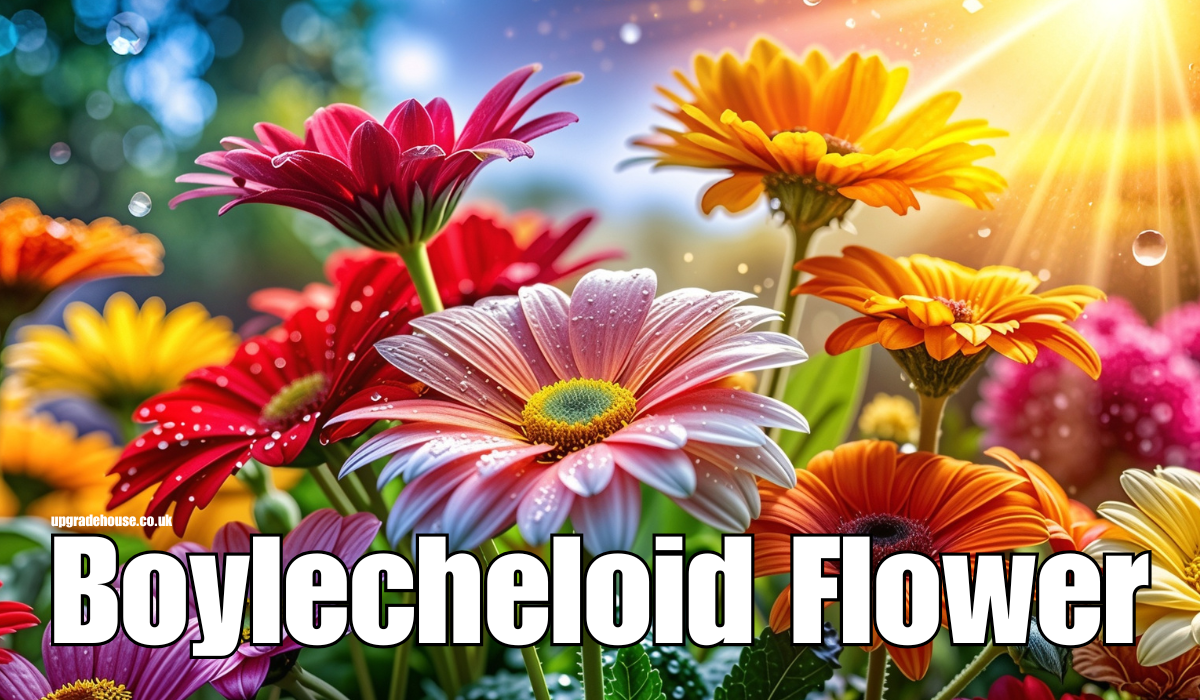The Boylecheloid flower is one of the most intriguing and enchanting plants a gardener can add to their collection. Known for its unusual petal designs, diverse color palette, and resilience, this flower has won the hearts of plant lovers across the world. What makes the Boylecheloid flower so appealing is its ability to blend beauty with durability. Unlike delicate flowers that demand constant attention, this plant adapts well to various conditions, making it ideal for both beginners and experienced gardeners. When you bring the Boylecheloid flower into your garden, you’re not just planting a flower—you’re introducing a symbol of resilience, elegance, and joy that will enrich your outdoor space for years to come. In this comprehensive guide, we’ll explore everything you need to know about the Boylecheloid flower, from planting tips to fun facts, so you can create a bright and thriving garden.
History and Origins of the Boylecheloid Flower
The history of the Boylecheloid flower is fascinating because, while it may not have the centuries of fame enjoyed by roses or tulips, it has steadily built a reputation among gardening enthusiasts. Believed to have originated in regions where wild varieties grew in rich soils, the Boylecheloid flower was first admired for its vibrant blooms and unique structure. Early cultivators noticed how adaptable the plant was, thriving in both mild and slightly harsh environments. As word spread, the Boylecheloid flower became a sought-after ornamental choice for gardens, parks, and even ceremonial plantings. Its rise in popularity is largely due to its blend of visual appeal and hardiness. Gardeners wanted a flower that was both beautiful and manageable, and the Boylecheloid flower fit that role perfectly. Today, it has become a global favorite, celebrated not just for its looks but also for the sense of vitality it brings to any setting.
Why the Boylecheloid Flower is Perfect for Every Garden
There are countless reasons why the Boylecheloid flower deserves a place in your garden. First, it offers an incredible range of colors, from soft pastels to bold and dramatic shades, giving you endless possibilities to design your space. Second, the plant is remarkably resilient, meaning even those new to gardening can enjoy success. Its ability to attract pollinators such as bees and butterflies also makes it an eco-friendly choice, contributing to biodiversity in your area. Additionally, the Boylecheloid flower is versatile enough to grow in gardens, containers, or even indoors, depending on the variety you choose. Unlike flowers that wilt quickly or demand excessive care, this bloom continues to flourish with basic maintenance, rewarding you with long-lasting beauty. For gardeners who value both aesthetics and ease, the Boylecheloid flower is the perfect solution.
Planting Boylecheloid Flowers the Right Way
Planting the Boylecheloid flower properly sets the foundation for healthy growth and vibrant blooms. The first step is to choose a location with plenty of sunlight, as these flowers thrive in full sun to partial shade. Soil preparation is crucial—make sure the ground is well-draining, as overly wet conditions can lead to root problems. Enrich the soil with organic compost to boost fertility and encourage strong roots. When planting seeds or seedlings, maintain a spacing of 12 to 18 inches between each plant to allow proper airflow, which reduces disease risks. After planting, water generously to help the roots settle into their new home. Within a few weeks, you’ll notice healthy growth that will soon lead to colorful blooms.
Watering and Feeding Your Boylecheloid Flower
Like most plants, the Boylecheloid flower thrives when it receives the right balance of water and nutrients. Watering deeply two to three times per week is usually enough, although this depends on your climate and soil type. Avoid overwatering, as soggy soil can damage roots. When it comes to feeding, a balanced flower fertilizer applied monthly will provide essential nutrients for steady growth and bright blooms. Adding mulch around the base of the plant is another great way to conserve moisture, regulate soil temperature, and reduce weed growth. Together, these simple steps create the perfect environment for a healthy, thriving Boylecheloid flower.

Light and Temperature Needs
The Boylecheloid flower is highly adaptable, but it still prefers certain conditions for optimal growth. Ideally, place the plant in a location where it receives at least six hours of direct sunlight daily. Partial shade is also acceptable, especially in hotter climates where too much sun may stress the plant. Temperature-wise, the Boylecheloid flower enjoys mild to warm weather but can withstand occasional fluctuations. However, if you live in an area with harsh winters, it’s best to grow the flower in pots so you can move them indoors when temperatures drop. Providing the right light and temperature conditions ensures that your Boylecheloid flower remains vibrant year-round.
Colors of the Boylecheloid Flower
One of the standout features of the Boylecheloid flower is its spectacular variety of colors. Whether you prefer bright yellows that bring sunshine to your garden, deep purples that create a dramatic backdrop, soft pinks that radiate romance, or crisp whites that exude purity, the Boylecheloid flower has it all. Many gardeners enjoy mixing several colors in one space to create eye-catching displays that shift with the seasons. These diverse hues make the Boyecheloid flower an excellent choice for both formal gardens and casual spaces, as well as for floral arrangements that bring natural beauty indoors.
Types of Boylecheloid Flowers
The Boylecheloid flower comes in several distinct varieties, each suited to different gardening needs. The Boylecheloid Grandiflora, for example, is known for its large, showy blossoms that instantly become the centerpiece of any garden. The Boylecheloid Dwarf is compact and perfect for container gardening, patios, and balconies. For something more decorative, the Boylecheloid Variegata features striking leaves with colorful streaks, providing beauty even when the plant isn’t blooming. Finally, the Boylecheloid Climber can be trained to grow on trellises and fences, creating a lush and flowering wall. With so many types available, you can choose the perfect Boylecheloid flower variety for your space.
Pruning and Deadheading
Pruning plays a vital role in maintaining the health and appearance of the Boylechloid flower. Regularly trimming away dead or damaged stems encourages new growth and prevents the plant from becoming overcrowded. Deadheading, or removing faded blooms, is equally important because it signals the plant to produce more flowers. This simple practice extends the blooming season and keeps your garden looking fresh. Using clean, sharp tools ensures that cuts heal quickly and reduces the risk of infection. By keeping up with pruning and deadheading, your Boylecheloid flower will reward you with continuous beauty.
Propagation of the Boylecheloid Flower
For gardeners who want to expand their collection, propagating the Boyecheloid flower is both simple and rewarding. The most common methods include seed sowing, stem cuttings, and root division. Seeds can be started indoors in trays before transferring outdoors once seedlings are strong. Stem cuttings, taken from healthy plants, root quickly when placed in moist soil. Root division is another effective method, especially for mature plants that have grown too large for their containers. Each propagation technique ensures you can enjoy even more of these stunning flowers without buying new plants every season.
Seasonal Care Tips
Different seasons require slightly different approaches to caring for your Boylcheloid flower. In spring, focus on planting, fertilizing, and encouraging growth. Summer requires regular watering and deadheading to keep blooms vibrant. Autumn is the time to prune and prepare for cooler weather, while winter care involves protecting the plant from frost, either by mulching heavily or bringing pots indoors. Adapting your care routine to the seasons ensures that your Boylecheloid flower remains healthy and beautiful all year long.
Common Pests and Diseases
Like all plants, the Boylecheloid flower may occasionally face pests or diseases. Common pests include aphids, spider mites, and caterpillars, which can damage leaves and flowers. Natural solutions such as neem oil sprays or introducing beneficial insects like ladybugs can help control these problems. Fungal issues may occur if the plant is grown in overly damp conditions, so good drainage and proper spacing are essential. By monitoring your Boylechelod flower regularly, you can spot issues early and take quick action to protect your plant.
Symbolism and Meaning of the Boylecheloid Flower
Beyond its physical beauty, the Boylecheloid flower carries symbolic meanings that add depth to its appeal. Many cultures view it as a symbol of resilience, thanks to its ability to thrive in various environments. Its bright colors represent joy, positivity, and new beginnings, making it a popular choice for celebratory occasions. Some people believe the Boylechelid flower brings harmony and balance to a garden, enhancing the emotional well-being of those who spend time among the blooms. By planting this flower, you’re not only beautifying your space but also adding layers of meaning to your garden.
Landscaping with Boylecheloid Flowers
The Boylecheloid flower is a versatile addition to landscaping projects. Its bold colors and different varieties make it suitable for borders, flowerbeds, or as a standout centerpiece. Climbing types are perfect for covering trellises, while dwarf types look stunning in containers lining patios and walkways. Mixing different colors and varieties can create a layered, dynamic garden that changes throughout the season. Professional landscapers often use the Boyleheloid flower to add both structure and softness to outdoor designs, making it an ideal plant for transforming any space.

Indoor Growing of Boylecheloid Flowers
While the Boylecheloid flower thrives outdoors, certain varieties are perfect for indoor growing as well. Dwarf types and compact varieties adapt well to pots placed near sunny windows. Indoor Boylecheloid flowers not only brighten up living spaces but also improve air quality and create a calming environment. Regular watering, occasional feeding, and proper light exposure are all it takes to maintain their beauty indoors. This makes the Boylecheloid flower a wonderful option for people who may not have outdoor gardens but still want to enjoy the joy of flowering plants.
Fun Facts About the Boylecheloid Flower
The Boylecheloid flower comes with many interesting facts that make it even more fascinating. For instance, some varieties release a subtle fragrance in the evening, adding a sensory element to your garden experience. These flowers are also known to bloom longer than many seasonal flowers, keeping your garden colorful for extended periods. Additionally, the Boylecheloid flower is highly attractive to pollinators, meaning you’re helping local ecosystems thrive by planting them. With their unique petal structures, they often stand out in flower shows and exhibitions, making them favorites among horticultural enthusiasts.
FAQs
Q1: Is the Boylecheloid flower easy to grow?
Yes, it is highly beginner-friendly and requires only basic care.
Q2: Can Boylecheloid flowers grow indoors?
Absolutely, especially compact or dwarf varieties placed in sunny spots.
Q3: How often should I water the Boylecheloid flower?
Water deeply two to three times per week, adjusting for climate.
Q4: Do Boylecheloid flowers attract pollinators?
Yes, bees and butterflies are especially drawn to them.
Q5: What is the lifespan of the Boylecheloid flower?
With proper care, many varieties bloom repeatedly across the growing season.
Read Also: Travel Hacks Cwbiancavoyage Tips for Stress-Free Trips

